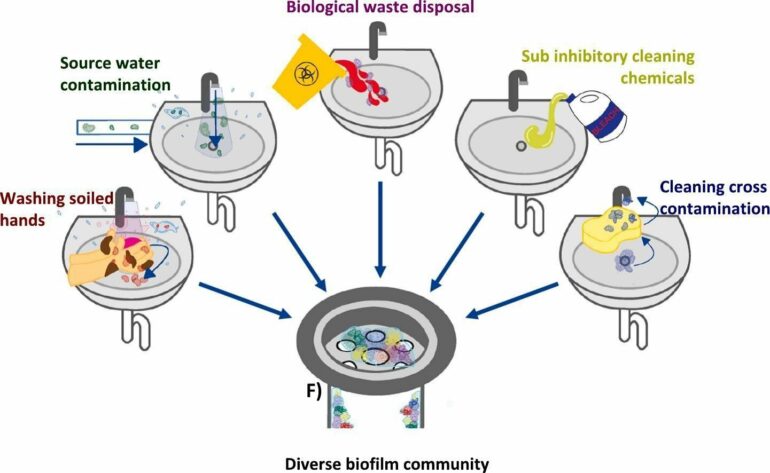Handbasins are hotspots for dangerous microbes that can cause illnesses including pneumonia, Legionnaires’ disease and wound infections, a new study from Flinders University warns.
The Flinders University environmental health study found handbasin biofilms contained a diverse range of pathogens including microbes typically found in water, and other pathogens not found in water.
“This research shows that handbasins may be playing a significant and underestimated role in health care–associated infections,” says Associate Professor Harriet Whiley, from the College of Science and Engineering and ARC Training Center for Biofilm Research and Innovation.
“The study also found that residential handbasins have a more diverse bacterial community present on handbasin biofilms compared with hospitals.
“There was also a higher number of Legionella bacteria present in the residential samples compared with those taken from hospitals.”
Legionnaires’ disease is caused by the Legionella bacteria, found in natural bodies of water, spas, warm water systems, potting mix and air-conditioning. A system that used water for cooling was linked to a large outbreak in Melbourne recently which affected almost 90 people and caused two deaths.
Biofilms, a slimy substance found on drains and around the faucet of handbasins, contain a community of microbes including disease-causing pathogens that can pose a threat to human health.
These pathogens are likely transferred to the biofilm from patients or staff during handwashing, from incoming water supply or biological waste, according to the study published in Science of the Total Environment.
The new study compared biofilms in hospital and residential handbasins to assess infection risk levels and possible routes of contamination.
Lead researcher Claire Hayward says, “The difference in the diversity of the microbial communities could be due to more regular cleaning, usage and the design of basins in hospitals through the implementation of health care infection control practices.
“This poses a risk to patients receiving health care in the home, which has been emerging as an alternative to extensive inpatient hospital stays to reduce the burden on the health care system.
“Patients receiving health care in the home need to be informed of infection control practices such as cleaning handbasin outlets and drains using effective disinfectants,” she says.
“Biofilms formed in the faucet and drains of handbasins can potentially harbor pathogenic microbes and increase the rise of antimicrobial resistance,” says Ph.D. candidate Hayward.
“In both settings we found a high abundance of pathogenic and corrosive germs, including some not typically carried in water.
“These complex and diverse microbial communities also differed depending on building type and indicate hospitals also need more control guidelines to manage these under-recognized areas of potential infection.”
The Australian Guidelines for the Prevention and Control of Infection in Health care recommends cleaning handwashing basins up to twice a day with detergent, along with other high-touch surfaces such as light switches, doorknobs and bedrails with the same frequency.
Researchers recommend further research into cleaning protocols and hand basin design to reduce risks.
More information:
Claire Hayward et al, Handwashing basins and healthcare associated infections: Bacterial diversity in biofilms on faucets and drains, Science of The Total Environment (2024). DOI: 10.1016/j.scitotenv.2024.175194
Provided by
Flinders University
Citation:
Hand washing is important—but is your handbasin clean? (2024, August 13)



